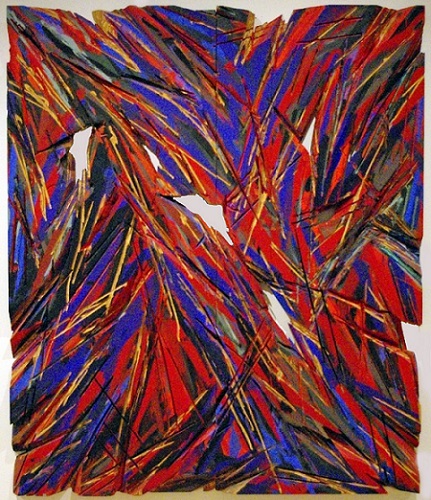
Charles Arnoldi
American, 1946-
Landfisher, 1983
acrylic on plywood
90 x 75 3/4 x 4 in.
SBMA, Gift of the Contemporary Collectors Group
1983.13

Portrait copyright Alan Bamberger 1998-2010
“Well, trying to make a painting look good isn’t easy.” - Charles Arnoldi
RESEARCH PAPER
Charles Arnoldi was born in Dayton, Ohio, in 1946. As a youth he was always making something, always using his hands. He admits, “I would get attention,…which is what I missed from my parents.” (Arnoldi, p. 60) Following an abusive childhood, he fled to Southern California in 1964. He spent two years at Ventura Junior College before earning a full scholarship to the Art Center School in Los Angeles, where he remained for only two weeks (he claims that they were trying to make him an illustrator). He enrolled in the Chouinard Art Institute, but he lost his grants and loans and left the school after eight months because he won the Young Talent Award from the Los Angeles Country Museum in 1969. (Frankel, p. 5) Soon he found himself immersed in the vibrant art community of Los Angeles, sharing a loft with the artist Laddie John Dill, and together running a picture framing business to earn a living.
Arnoldi established himself as a major Los Angeles artist in the decade of the 1970s, when painting was supposed to be dead, and the artist was challenged to work with new materials and in larger sizes. Arnoldi began using tree branches instead of brushwork: “I used tree branches because they looked like hand-drawn lines, but I didn’t have to draw them.” (Butterfield in Frankel, p. 6) His early works consisted of open, lattice work of branches, painted by the artist and displayed flat against a wall, often with a frame of similarly treated branches. These wall drawings existed sculpturally in space but were also viewed as paintings. Some have suggested that this return to the natural, to the organic, was a revolt against the hard-edge, stark Minimalism of the 1970s. (See Gardner 1986 and 1987.)
In the early 1980s he began experimenting with larger constructions of sticks assembled as free-standing, architectonic sculptures. Some of these he also cast in bronze. Arnoldi, if nothing else, is an artist always seeking something new, something challenging to the way he previously worked. He continued his evolution of styles with a group of painting/sculptures called the “Chainsaw” series, of which “Landfisher” is representative.
While visiting the caretaker of the land where he had gathered tree branches, he noticed large chunks of wood with the marks of the woodsman’s chainsaw. After experimenting with painting some of these blocks, Arnoldi decided to work with thick pieces of plywood, which he prepared himself by glueing together several sheets of plywood. On these he creates a painting to guide him in his cutting with a chainsaw. “That surface painting is very unprecious to me, and I feel really loose when I do it because I don’t feel as if I am going to have to stand by the image.” (Butterfield in Frankel, pp. 112-113)
“Landfisher” is a stunning example of the resulting chainsaw paintings, for it works on many levels. On the visual level the slashing lines are negative images replacing the sticks; the wooden figure of the stick paintings (tree branches) becomes the wooden ground of the chainsaw works (plywood). The lines and gestures are negative space. These works are reductive and reflect the popularity of the deconstruction theories of the 70s and 80s. “In some pieces, the cuts go all the way through. I realized I could put a negative line, so I was, in effect, drawing in negative space.” (Arnoldi in Arnoldi, pp. 81-82)
After the slashing lines of the chainsaw exposed deep cuts, Arnoldi added more paint in addition to the paint on the original surface, creating more flashes of color to further hide the wood-ness of the medium. We are left with positive and negative space competing for prominence in a work which evokes grand and basic emotional responses.
On the psychological level the chainsaw paintings suggest horror and dismemberment (remember the film “Texas Chainsaw Massacre” from 1974?). The noisy, dangerous, and brutal tool may create anxiety in both the user and the observer, but the aggression and power necessary to carve these wooden planks connotes a muscularity and masculinity which is entirely offset by the sheer beauty of the painted surface.
Indeed, in all of Arnoldi’s work we see opposites which are sometimes difficult to reconcile. The wooden pieces are both paintings and sculptures. They are natural as wooden objects but unnatural with their painted surface. Psychologically aggressive but artistically compelling, physical yet emotional. The wood carving is at once primitive and also modern.
One cannot look at “Landfisher” without feeling the physical energy it took to produce such a work. This dynamism coupled with its imposing size and vibrant primary colors leaves one in awe of the power of artistic expression.
Arnoldi continues to experiment and change. Following the death of close family members as well as renewal with the birth of his first child in 1988, Arnoldi returned to the painted canvas with brushstrokes replacing the lines of wooden sticks. These in turn were followed by series of paintings with biomorphic shapes, then hard-edge colored ellipses, and then colorful panels of geometric shapes.
Never an artist to allow a single style to dominate his career, Chuck Arnoldi summarizes his work as an artist by observing, “My whole life is about imagination. All I see are the possibilities.” (Burton/Hamilton in Glenn, p. 18)
Prepared for the Santa Barbara Museum of Art Docent Council by Ralph Wilson, 2013.
BIBLIOGRAPHY
Monographs
Arnoldi, Charles. “Charles Arnoldi”. With a Foreword by Frank Gehry, Essay by Dave Hickey, A Conversation with Charles Arnoldi: Gregory Amenoff, Fred Hoffman, Charlotte Jackson and Michael Zakian. Santa Fe, New Mexico: Radius Books, 2008.
Catalogs
Edgerton, Anne Carnegie, and Maurice Tuchman. “Young Talent Awards: 1965–1985”. Bulletin 1985. Los Angeles: Los Angeles County Museum of Art, 1985.
Frankel, Dextra. “Charles Arnoldi and Laddie John Dill”. With essays by Jan Butterfield. Main Art Gallery, Visual Arts Center. Fullerton, California: California State University, Fullerton, 1983.
Glenn, Constance W., and Jane K. Bledsoe, eds. “Arnoldi: Just Bronze”. With essays by Constance W. Glenn, Peter Clothier, Mary Drobny, Ann Mailander, and Cynthia Burton and Mary Hamilton with Rachael Duarte. Long Beach, California: California State University, Long Beach, 1987.
Hoffman, Fred. “Charles Arnoldi: A Mid-Career Survey 1970-1996”. Introduction by Frank O. Gehry, Essay by Sam Hunter. Santa Monica, California: Fred Hoffman Fine Art, 1996.
Subler, Craig Allen, Director. “Arnoldi: Recent Paintings”. Essay by Nicholas Wilder. Kansas City, Missouri: University of Missouri-Kansas City Gallery of Art, 1986.
Periodicals
Curtis, Cathy. “Arnoldi Branches Out to Bronze.” Los Angeles Times, December 4, 1987, Part VI, p. 19.
———. “Galleries.” Los Angeles Times, May 27, 1988, Part VI, p. 18.
Gardner, Colin. “Galleries.” Los Angeles Times, February 28, 1986, Part VI, p. 9.
——— “Galleries.” Los Angeles Times, March 20, 1987, Part VI, pp. 13-14.
Kandel, Susan. “Conjuring Up Illusions of Enchanting Magnetism.” Los Angeles Times, June 6, 1996, Part F, p. 5.
Muchnic, Suzanne. “Painterly Power of Arnoldi Prints.” Los Angeles Times, May 8, 1984, Part VI, p. 6.
———. “The Galleries.” Los Angeles Times, January 4, 1985, Part VI, p. 9.
Rian, Jeffrey. “Charles Arnoldi at Charles Cowles.” Art in America, February 1988, pp. 142-143.
Wilson, William. “The Art Galleries.” Los Angeles Times, December 13, 1985, Part VI, p. 16.
Winter, David. “Charles Arnoldi/Fuller Goldeen.” ARTnews, Summer 1985, p. 101.
Websites
Charles Arnoldi Studio
http://www.charlesarnoldistudio.com/
R. B. Stevenson Gallery
http://www.rbstevensongallery.com/pages/charlesarnoldi/biography.html
Ro Gallery
http://www.rogallery.com/arnoldi/arnoldi-charles-biography.html
POSTSCRIPT
During a telephone conversation with artist Chuck Arnoldi in November, 2013, I asked him about the meaning and genesis of the title “Landfisher”. The following are some of his responses during that discussion:
“When I was a younger artist, I decided not to repeat myself. I didn’t want to create a style, a branding to be my identity. Of course I was purely abstract, so I left every painting untitled. Later when people wanted to describe a work, I was at a disadvantage because there was no way for me to identify which one they were talking about. So I added titles for my own recall…."
“Usually my titles come from some current event or something going on at the time."
“Every now and then my assistant says we’re running out of titles, so we sit down and I just start naming. Often he’ll say I’ve already got a piece with that name. Actually there are a couple of pieces out there with the same name. It’s going to be a real problem for my kids when I die, trying to organize all of this stuff…."
"'‘Landfisher’ is just a name for me to recall. I do not remember what was happening at the time. I really like the name. Once I heard about a plane crash and they were talking about how long it took for a plane to crash. So I named the piece I was working on ‘23.6 Seconds’…. “
- Ralph Wilson, December 2013
